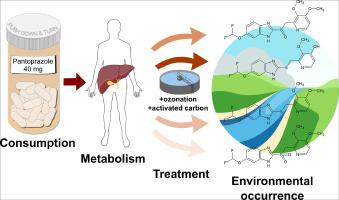当前位置:
X-MOL 学术
›
Water Res.
›
论文详情
Our official English website, www.x-mol.net, welcomes your feedback! (Note: you will need to create a separate account there.)
Metabolites are overlooked in environmental risk assessments and monitoring of pharmaceuticals: The case study of pantoprazole
Water Research ( IF 11.4 ) Pub Date : 2024-04-09 , DOI: 10.1016/j.watres.2024.121596 Finnian Freeling , Dominic Armbruster , Karsten Nödler , Uwe Kunkel , Marco Scheurer , Jan Koschorreck , Thomas A. Ternes
Water Research ( IF 11.4 ) Pub Date : 2024-04-09 , DOI: 10.1016/j.watres.2024.121596 Finnian Freeling , Dominic Armbruster , Karsten Nödler , Uwe Kunkel , Marco Scheurer , Jan Koschorreck , Thomas A. Ternes

|
The proton-pump inhibitor pantoprazole (PPZ) is one of the most consumed pharmaceuticals worldwide. Despite its high usage, reported PPZ concentrations in environmental water samples are comparatively low, which can be explained by the extensive metabolism of PPZ in the human body. Since most previous studies did not consider human PPZ metabolites it can be assumed that the current environmental exposure associated with the application of PPZ is substantially underestimated. In our study, 4′--demethyl-PPZ sulfide (M1) was identified as the predominant PPZ metabolite by analyzing urine of a PPZ consumer as well as the influent and effluent of a wastewater treatment plant (WWTP) using liquid chromatography coupled to high resolution mass spectrometry (LC-HRMS). M1 was found to be ubiquitously present in WWTP effluents (max. concentration: 3 000 ng/L) and surface waters in Germany. On average, the surface water concentrations of M1 were approximately 30 times higher than those of the parent compound PPZ. Laboratory scale experiments demonstrated that activated carbon can considerably adsorb M1 und thus improve its removal during wastewater and drinking water treatment. Laboratory ozonation experiments showed a fast oxidation of M1, accompanied by the formation of several ozonation products. Certain ozonation products (identities confirmed via synthesized reference standards) were also detected in water samples collected after ozonation in a full-scale WWTP. Overall lower signal intensities were observed in the effluents of a sand filter and biologically active granular activated carbon filter, suggesting that the compounds were significantly removed during these post-ozonation treatment stages.
中文翻译:

环境风险评估和药品监测中代谢物被忽视:泮托拉唑案例研究
质子泵抑制剂泮托拉唑 (PPZ) 是全球消费最多的药物之一。尽管其使用量很高,但据报道,环境水样中的 PPZ 浓度相对较低,这可以通过 PPZ 在人体内的广泛代谢来解释。由于大多数先前的研究没有考虑人类 PPZ 代谢物,因此可以假设当前与 PPZ 应用相关的环境暴露被大大低估。在我们的研究中,通过使用液相色谱与高效液相色谱联用技术分析 PPZ 消费者的尿液以及废水处理厂 (WWTP) 的进水和出水,4'-去甲基-PPZ 硫化物 (M1) 被确定为主要的 PPZ 代谢物。分辨率质谱(LC-HRMS)。在德国,M1 普遍存在于污水处理厂废水(最大浓度:3 000 ng/L)和地表水中。平均而言,M1 的地表水浓度比母体化合物 PPZ 高约 30 倍。实验室规模的实验表明,活性炭可以显着吸附 M1,从而提高废水和饮用水处理过程中 M1 的去除率。实验室臭氧化实验表明M1 快速氧化,并伴随着多种臭氧化产物的形成。在全规模污水处理厂臭氧化后收集的水样中也检测到了某些臭氧化产物(通过合成参考标准确认的身份)。在砂滤器和生物活性颗粒活性炭过滤器的流出物中观察到总体较低的信号强度,这表明这些化合物在这些臭氧化后处理阶段被显着去除。
更新日期:2024-04-09
中文翻译:

环境风险评估和药品监测中代谢物被忽视:泮托拉唑案例研究
质子泵抑制剂泮托拉唑 (PPZ) 是全球消费最多的药物之一。尽管其使用量很高,但据报道,环境水样中的 PPZ 浓度相对较低,这可以通过 PPZ 在人体内的广泛代谢来解释。由于大多数先前的研究没有考虑人类 PPZ 代谢物,因此可以假设当前与 PPZ 应用相关的环境暴露被大大低估。在我们的研究中,通过使用液相色谱与高效液相色谱联用技术分析 PPZ 消费者的尿液以及废水处理厂 (WWTP) 的进水和出水,4'-去甲基-PPZ 硫化物 (M1) 被确定为主要的 PPZ 代谢物。分辨率质谱(LC-HRMS)。在德国,M1 普遍存在于污水处理厂废水(最大浓度:3 000 ng/L)和地表水中。平均而言,M1 的地表水浓度比母体化合物 PPZ 高约 30 倍。实验室规模的实验表明,活性炭可以显着吸附 M1,从而提高废水和饮用水处理过程中 M1 的去除率。实验室臭氧化实验表明M1 快速氧化,并伴随着多种臭氧化产物的形成。在全规模污水处理厂臭氧化后收集的水样中也检测到了某些臭氧化产物(通过合成参考标准确认的身份)。在砂滤器和生物活性颗粒活性炭过滤器的流出物中观察到总体较低的信号强度,这表明这些化合物在这些臭氧化后处理阶段被显着去除。











































 京公网安备 11010802027423号
京公网安备 11010802027423号